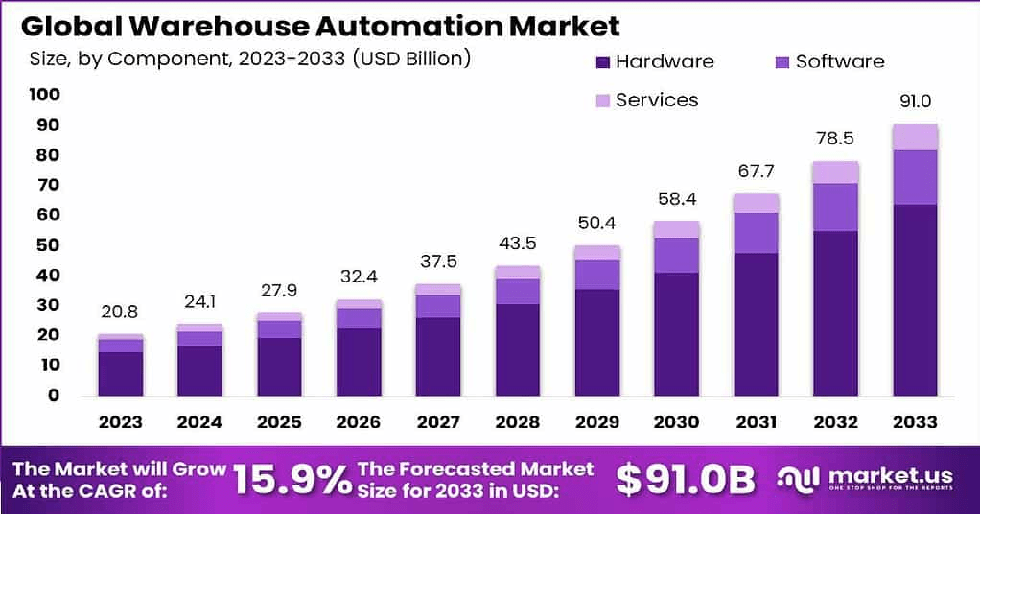Introduction
The Global Warehouse Automation Market is set to expand from USD 20.8 billion in 2023 to USD 91.0 billion by 2033, with a CAGR of 15.9%. Warehouse automation optimizes supply chain operations, enhancing efficiency and accuracy through robotics, AI, and IoT. Driven by e-commerce growth, labor shortages, and technological advancements, the market serves industries like retail, logistics, and manufacturing. By streamlining processes such as picking, packing, and inventory management, automation ensures faster delivery and cost savings, positioning it as a critical enabler of modern, scalable supply chains in a rapidly evolving global market.
Key Takeaways
-
Market Growth: USD 20.8 billion in 2023 to USD 91.0 billion by 2033, at a 15.9% CAGR.
-
Growth Drivers: E-commerce surge, labor shortages, and technological innovation.
-
Leading Segments: Robotics, e-commerce, and software solutions dominate.
-
Challenges: High costs, integration complexities, and skill shortages.
-
Outlook: North America leads; Asia-Pacific grows fastest due to e-commerce expansion.
Component Analysis
Components include hardware, software, and services. Hardware held a 58% share in 2023, driven by demand for robots and automated conveyors. Software, growing at a 19% CAGR, enables real-time inventory tracking and process optimization. Services support installation and maintenance. Hardware dominates for its essential automation role, while software drives growth by enhancing system intelligence and operational efficiency in warehouses.
End-Use Industry Analysis
End-use industries include e-commerce, logistics, manufacturing, and retail. E-commerce led with a 42% share in 2023, fueled by booming online retail. Logistics, growing at a 18% CAGR, supports scalable supply chains. Manufacturing and retail prioritize operational efficiency. E-commerce dominates due to high order volumes, while logistics drives growth, propelled by global supply chain demands and automation adoption.
Market Segmentation
-
By Component: Hardware, Software, Services
-
By Technology: Robotics, AGVs, IoT, AI, Others
-
By End-Use Industry: E-commerce, Logistics, Manufacturing, Retail, Others
-
By Automation Type: Picking, Packing, Sorting, Storage
-
By Region: North America, Asia-Pacific, Europe, Latin America, Middle East & Africa
Driver
Exponential Growth of the E-commerce Industry
The explosive growth of the e-commerce industry serves as a primary driver for the warehouse automation market. With the rapid expansion of online shopping, businesses are under pressure to fulfill orders quickly and efficiently. This demand for speed and accuracy in order fulfillment necessitates advanced warehouse automation solutions.
Automation technologies, such as Automated Guided Vehicles (AGVs), Automated Storage and Retrieval Systems (AS/RS), and robotic picking systems, enable e-commerce companies to enhance operational efficiency, reduce order processing times, and improve customer satisfaction. As consumer expectations for fast delivery continue to rise, the reliance on warehouse automation technologies becomes increasingly crucial for e-commerce businesses to stay competitive and meet market demands.
Restraints
High implementation costs and integration challenges limit adoption, especially for SMEs. Skill shortages in automation technologies hinder deployment. Compatibility issues with legacy systems pose barriers. Addressing these requires cost-effective solutions, workforce training, and standardized integration frameworks to ensure scalable warehouse automation across industries.
SWOT Analysis
-
Strengths: Increased efficiency, scalability, and cost optimization.
-
Weaknesses: High costs, skill gaps, and integration complexities.
-
Opportunities: E-commerce growth, AI advancements, and emerging markets.
-
Threats: Economic fluctuations and technological obsolescence. This analysis underscores automation’s transformative potential while highlighting cost and skill barriers.
Trends and Developments
Trends include AI-driven robotics, IoT-enabled inventory tracking, and cloud-based automation platforms. Investments, like KION Group’s $250 million tech fund in 2023, fuel innovation. Partnerships, such as Swisslog’s logistics collaborations, enhance adoption. Sustainability and predictive analytics gain traction. These trends position warehouse automation as a catalyst for efficient, scalable supply chains globally.The Global Warehouse Automation Market is set to expand from USD 20.8 billion in 2023 to USD 91.0 billion by 2033, with a CAGR of 15.9%. Warehouse automation optimizes supply chain operations, enhancing efficiency and accuracy through robotics, AI, and IoT. Driven by e-commerce growth, labor shortages, and technological advancements, the market serves industries like retail, logistics, and manufacturing. By streamlining processes such as picking, packing, and inventory management, automation ensures faster delivery and cost savings, positioning it as a critical enabler of modern, scalable supply chains in a rapidly evolving global market.
Key Player Analysis
Key players include Amazon Robotics, Dematic, KION Group, Honeywell Intelligrated, and Swisslog. Amazon Robotics and Dematic lead in robotic automation. KION Group excels in AGVs, Honeywell in software solutions, and Swisslog in integrated systems. Strategic alliances and acquisitions strengthen market positions, driving innovation in warehouse automation.
- Honeywell International Inc.
- Oracle Corporation
- Daifuku Co. Ltd.
- Dematic
- Swisslog Holding AG
- KNAPP AG
- BEUMER Group
- ABB Ltd.
- FANUC Corporation Company Profile
- Vanderlande
- SSI Schaefer
- KION Group
- Softeon
- Manhattan Associates
- Other Key Players
Conclusion
The Global Warehouse Automation Market, growing from USD 20.8 billion in 2023 to USD 91.0 billion by 2033 at a 15.9% CAGR, is reshaping logistics. Despite cost and skill challenges, technological advancements drive efficiency. Investments and partnerships will ensure scalable, transformative growth.
- Revolutionizing Logistics: Global Warehouse Automation Market 2024-2033
- The Global Warehouse Automation Market is set to expand from USD 20.8 billion in 2023 to USD 91.0 billion by 2033, with a CAGR of 15.9%. Warehouse automation optimizes supply chain operations, enhancing efficiency and accuracy through robotics, AI, and IoT. Driven by e-commerce growth, labor shortages, and technological advancements, the market serves industries like retail, logistics, and manufacturing. By streamlining processes such as picking, packing, and inventory management, automation ensures faster delivery and cost savings, positioning it as a critical enabler of modern, scalable supply chains in a rapidly evolving global market.
- warehouse, logistics, automation,
Related posts:
 Best Website Designer and Web Design Solutions with Cyberworx Technologies
Best Website Designer and Web Design Solutions with Cyberworx Technologies
 Enjoy Ultra 9000 Box of 10 – Power, Flavour, and Convenience Combined
Enjoy Ultra 9000 Box of 10 – Power, Flavour, and Convenience Combined
 Crystal Pro Max + 10000 Box of 10: Long-Lasting Flavour from a Trusted Vape Store in UK
Crystal Pro Max + 10000 Box of 10: Long-Lasting Flavour from a Trusted Vape Store in UK
 Outrank Competitors with Help from a Trusted Denver SEO Agency
Outrank Competitors with Help from a Trusted Denver SEO Agency
 Gojek Clone: Launch a Successful All-In-One Service Platform in 2025
Gojek Clone: Launch a Successful All-In-One Service Platform in 2025
 Why Search Intent Mapping Is Becoming the New Enterprise Content Strategy
Why Search Intent Mapping Is Becoming the New Enterprise Content Strategy
 How to Watch Live HD Streams on Sportsurge – Complete Guides
How to Watch Live HD Streams on Sportsurge – Complete Guides
 Discover Expert Massage Therapy Near New Hope with BetterHealthConcept
Discover Expert Massage Therapy Near New Hope with BetterHealthConcept






